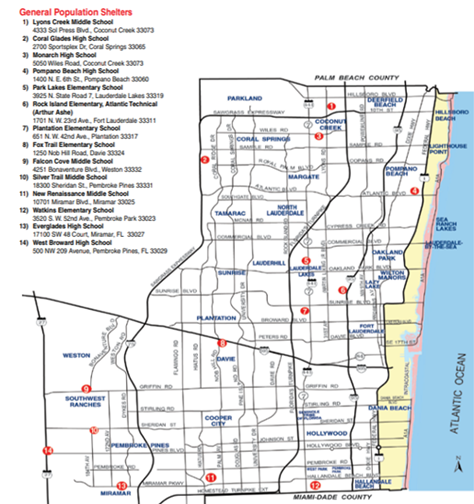Hurricane Season is June 1st to November 30th
Are You Ready?
Florida Hurricane Preparedness Guide 2025
Presented by Yon Law – Florida’s Property Damage Claim Specialists
Florida’s hurricane season spans from June 1 through November 30, and early forecasts for 2025 indicate an above-average season, with projections of at least 19 named storms and 9 hurricanes.
Whether you’re a lifelong Floridian or a first-timer, preparation can mean the difference between safety and disaster. The time to prepare is before the storm. YON LAW, a property damage attorney serving all of Florida, has compiled this guide with information you can use to help protect your home, your family, and your rights—before, during, and after the storm.
This Hurricane Preparation Guide is for general informational purposes only and does not constitute legal advice., It may not cover all relevant issues or apply to your specific situation. The author expressly disclaims any liability for any loss or damage resulting from reliance on the information contained in this guide. Use of this guide does not create an attorney-client relationship. For advice tailored to your circumstances, consult a licensed attorney.

Know the Risks
- Storm surge: Deadliest threat, especiallynear coastlines
- Inland flooding: Can occur even in non-flood zones
- High winds: Cause structural damage anddowned power lines
- Tornadoes: Embedded in rain bands ornear the storm’s center
- Rip currents: Dangerous even when skiesare clear
Determine What Zone you are in
- Flood zone (even in areas outside official zones may flood)
- Evacuation Zone
Inspect your home’s vulnerabilities
- roofing, windows, garage doors, drainage systems
Resources:
- Flood Zones: NOAA’s Coastal Flood Exposure Mapper
- Evacuation Zones: Florida Evacuation Zone Lookup

HURRICANE BASICS
What is a Hurricane?
Hurricanes are large rotating storms, often referred to as tropical cyclones, that form over warm waters in tropical areas. Hurricanes begin when a tropical depression forms in the ocean. A tropical depression is a line of rain showers and weak thunderstorms that circle around an area of low air pressure. The low air pressure causes the hot, humid air from the ocean to rise in a spiral shape. As that warm air rises, it releases heat, cools down, and condenses into gusty bands of clouds and storms. When winds reach 39 miles an hour, the tropical depression becomes a tropical storm. When winds reach 74 miles an hour, it’s officially a hurricane.
Hurricane Watch
An announcement that sustained winds of 74 mph or higher are possible within the specified area in association with a tropical, subtropical, or post-tropical cyclone. A hurricane watch is issued 48 hours in advance of the anticipated onset of tropical storm force winds.
Hurricane Warning
An announcement that sustained winds of 74 mph or higher are expected somewhere within the specified area in association with a tropical, subtropical, post-tropical cyclone. A Hurricane Warning is issued 36 hours in advance of the anticipated onset of tropical storm force winds.


74-95 MPH WINDS
Very dangerous winds will produce some damage: Well constructed frame homes could have damage to roof, shingles, vinyl siding and gutters. Snapped tree branches. Power outages likely

96-110 MPH WINDS
Well constructed frame homes could sustain major roof and siding damage. Trees snapped or uprooted. Near total power loss expected.

111-129 MPH WINDS
Devastating damage will occur: Well-Built framed homes may incur major damage or removal of roof decking and gable ends. Damaged trees blocking roads. Utilities unavailable for days or weeks.

130-156 MPH WINDS
Catastrophic damage will occur: Well-Built framed homes can sustain severe damage with loss of roof and/or some exterior walls. Trees and power poles down. Most of area will be uninhabitable.

157+ MPH WINDS
Catastrophic damage will occur: High percentage of framed homes destroyed. Fallen trees and power poles will isolate residential areas. Power outages will last weeks or months. Area uninhabitable.
FOR MORE DETAILED INFORMATION VISIT:
National Hurricane Center:
www.nhc.noaa.gov
Saffir-Simpson Scale:
https://www.nhc.noaa.gov/aboutsshws.php

STORM SURGE
What is Storm Surge?
Storm surge is the abnormal rise of water generated by a storm, over and above the predicted astronomical tide.
Storm Surge Watch
An announcement of the possibility of life-threatening inundation from rising water moving inland from the shoreline somewhere within the specified area, generally within 48 hours. The watch may be issued earlier when other conditions are expected to limit the time available to take protective actions for surge
Storm Surge Warning
An announcement of the danger of life-threatening inundation from rising water moving inland from the shoreline somewhere within the specified area, generally within 36 hours. The warning may be issued earlier when other conditions are expected to limit the time available to take protective actions for surge.
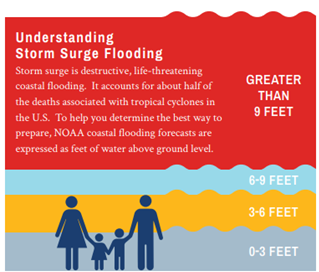
Hurricanes, tropical storms, and depressions bring multiple dangers that can impact every part of Florida, not just coastal areas.

tornados
What is a Tornado?
A rotating column of air touching the ground, usually attached to the base of a thunderstorm. Some tornadoes are clearly visible, while rain or nearby low hanging clouds obscure others. Tornado size can vary depending on the weather situation. Tornados are rated on the Enhanced Fujita (EF) Scale.
Tornado Watch
Is issued by the Storm Prediction Center when conditions are favorable for the development of tornadoes in and close to the watch area. Watches are usually issued for a duration of 4 to 8 hours. They are normally issued well in advance of the actual occurrence of severe weather.
Tornado Warning
Is issued by the National Weather Service when a tornado has been sighted or indicated by weather radar.
A Tornado Warning can be issued without a Tornado Watch already being in effect.

Avoid the Threat
If a Tornado Warning is issued or threatening weather approaches move to your pre-designated safe room, which is a small room near the center of the structure away from any windows if possible.
Gather blankets to cover yourself with to help protect you from flying debris.
Don’t forget to bring your pets into the safe room with you.
Resources:
Understand Tornado Alerts https://www.weather.gov/safety/tornado-ww
The Enhanced Fujita Scale (EF Scale) https://www.weather.gov/oun/efscale

Every family in Florida should be prepared to be self-sufficient for the first three to five days after a major storm, so emergency recovery efforts can focus on those who need help most.
You may only have a few hours—or less—to evacuate safely.
- Choose multiple destinations: family or friends outside evacuation zones, or hotels.
- Plan multiple routes in case roads are closed. Include your pets in all planning.
- If you don’t drive, identify public transportation or local assistance options now, check your county link below.
- Share your plan with family members and designate a primary emergency contacts outside your local area
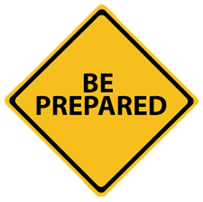
Do not wait until a storm is approaching to begin your preparedness. Being prepared is having all in readiness before Hurricane Season begins on June 1st.
Being prepared for a disaster is like being prepared for any other important event in life.
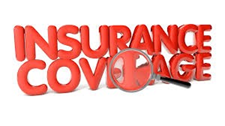
Insurance Check up
Check your homeowner’s policy limit and make sure the amount is enough to rebuild your home. Understand your hurricane/windstorm deductible. Understand what disasters your insurance policy covers, and those it doesn’t. Review your policy to ensure you’re adequately covered.
Photograph and inventory your possessions.
Keep documents with you if you evacuate.
If you rent, consider purchasing content coverage.
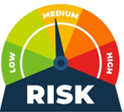
Know Your Risk
Do you live in a Hurricane Evacuation Zone?
Visit the Florida Division of Emergency Management
website and enter your address to Know Your Zone.
You can get your overall flood risk by clicking the link below.
Resources:
www.floridadisaster.org

contact information
Along with family members and friends, be sure to include your banking, insurance, and medical contacts. Include additional numbers that are important to you should you be away from home for an extended period. Keep all contact information up-to-date in a small notebook for easy access should you be ordered to evacuate

EVACUATIONS
Think ahead about evacuations.
If you are ordered to evacuate ...
WHERE WILL YOU GO?
HOW WILL YOU GET THERE?
Depending on the storm, residents may only need to move further inland.
Often 10 miles is enough.
Think 10s of miles, not 100s of miles.
Resources: Each County Shelter Information https://www.floridadisaster.org/planprepare/shelters
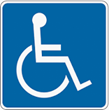
Do You Have Special Medical Needs?
If you or a family member have a disability or special medical need, additional considerations must be addressed when planning, evacuating, and sheltering.
DO NOT WAIT UNTIL THE LAST MINUTE.
PLAN AHEAD - BE PREPARED

Emergency Supply Kit
Ensure you and your family are prepared before a disaster strikes. If our community is impacted, you may lose access to basic services, such as power and water. Access to essentials like food and water may be limited.
STOCK UP ON ESSENTIALS AND PREPARE YOUR EMERGENCY SUPPLY KIT NOW
Prepare ahead for your medical needs such as dialysis, insulin, oxygen and any prescription drugs.
The emergency refill law now allows you to obtain a 30-day supply of medications when an emergency is declared.

DISASTER SUPPLY CHECKLIST
general
- Two week minimum supply of medication, regularly used medical supplies, and list of allergies
- A list of the style, serial number, and manufacturer information of required medical devices
- Batteries
- Flashlights
- NOAA Weather Radio
- Cash
- Banks and ATMs may not be available after a storm
- Cell phone chargers
- Books, games, puzzles, or other activities for children
IMPORTANT DOCUMENTS
- Insurance cards
- Medical records
- Banking information
- Credit card numbers
- Copies of social security cards
- Copies of birth and/or marriage certificates
- Other personal documents
- Set of car, house, and office keys
- Service animal I.D., veterinary records, and proof of ownership
- Information about where you receive medication, the name of the drug, and dosage
- Copy of Will
*Items should be kept in a waterproof container
PHONE NUMBERS
- Maintain a list of important phone numbers, including:
County emergency management office, evacuation sites, doctors, banks, schools, veterinarian, a number for out of town contacts, friends and family
CLOTHING
- Rain gear such as jackets,hats, umbrellas and rainboots
- Sturdy shoes or boots andwork gloves
vehicle
- Keep your motor vehicle tanks filled with gasoline
SPECIAL NEED ITEMS
- Specialty items for infants,small children, the elderly,and family members withdisabilities
FIRST AID
- First Aid Manual
- Sterile adhesive bandagesof different sizes
- Sterile gauze pads
- Hypoallergenic adhesivetape
- Triangular bandages
- Scissors
- Tweezers
- Sewing needle
- Moistened towellettes
- Antiseptic
- Disenfectant wipes
- Hand sanitizer
- Thermometer
- Tube of petroleum jelly
- Safety pins
- Soap
- Latex gloves
- Sunscreen
- Aspirin or other pain reliever
- Anti-diarrheal medicine
- Antacid
- Laxative
- Cotton balls
- Q-tips
FOOD AND WATER
- Food
- Nonperishable packaged or canned food and beverages, snack foods, juices, baby food, and any special dietary items to last at least 7 days
- Water (1 gallon per person per day)
- Non-electric can opener
- Paper plates
- Napkins
- Plastic cups
- Utensils
PET CARE ITEMS
- Pet food and water to last at least 7 days
- Proper identification
- Medical records/microchip information
- A carrier or cage
- Muzzle and leash
- Water and food bowls
- Medications
- Supplies for your service animal
Find more disaster preparedness tips at FloridaDisaster.org


Inspect Your Roof
Before hurricane season, have a licensed roof contractor inspect, perform repairs, and check the integrity of your roof.
Clear gutters and drains and trim nearby trees.
Protect Your Windows
Install impact resistant windows or hurricane shutters. Otherwise, be ready to cover your windows with 5/8” plywood when a storm is approaching.
Duct tape provides NO
Prepare Your Yard
Unhealthy trees and limbs, yard furniture and decorations are among the objects that could become deadly missiles in high winds. Keep your trees pruned, clean out your gutters on a regular basis, and when a storm is coming:
• Properly dispose of any piles of tree limbs or debris.
• Bring in all large yard items, such as furniture & grills
• Do not drain your pool, add extra chlorine, and turn off power to pool equipment


evacuation
An evacuation is a protective action to help save lives when a clear danger to life exists. It is a “mandatory” evacuation order because once issued, under Florida State Statute 252.36 (5)(e), evacuation is required. Returning to an evacuated area before the evacuation order is lifted is also prohibited.
Evacuations Save Lives
An Evacuation Order means that life-threatening conditions are possible in your area. You will not be ordered to evacuate unless there is a real threat to your well-being, or the possibility that you might become stranded where help could not reach you. Sometimes a few miles is enough. Think 10s of miles, not 100s of miles. Your safety, and the safety of others, may depend on it.
What If I Don’t Evacuate
If you do not evacuate when ordered, you may be on your own during a disaster. Emergency Responders will follow mandatory evacuation orders and may not be able to help those who do not evacuate. Roads may be inaccessible due to water, debris, or other hazards. Depending on the damage received from a storm, roads could be inaccessible for an extended period.
You may be left without electricity, internet, phone service, and water.
When you are told to evacuate, do so immediately
To learn more about evacuations, please visit: https://www.floridadisaster.org/evacuation-orders/

SHELTERING
Sheltering During A Disaster Taking shelter is necessary in many emergencies. Your Disaster Plan should include your Sheltering Plan. Will you be sheltering outside the evacuation area or at one of the local evacuation shelters?
If you plan to use one of the local shelters, familiarize yourself with their locations. By planning for several destinations, you have options when an evacuation is ordered.
Sheltering will involve living with many people in a confined space. There will be little privacy, which can prove to be difficult and unpleasant.
It is important for all sheltered individuals to be considerate of one another and to cooperate with shelter managers and staff to make your stay as pleasant, and stress free as possible.
Shelter Supply Kit
Cot or air mattress, blankets, sheets and pillows. There may not be cots or bedding available at the general shelters.
Drinks and snack foods are suggested to help between meals. If you require specialized foods, you must bring it.
7-day supply of medications and supplies. If you are a diabetic on insulin, bring a small cooler for your insulin (or any refrigerated medications).
Baby food and diapers for infants
Toiletries: Brush, deodorant, soap, towel, washcloth, shampoo, shaving supplies, toothbrush, toothpaste, etc.
Extra clothing, rain gear, closed toe shoes
Eyeglasses, hearing aids, batteries
Cane, walker, wheelchair
Entertainment items: cards, toys, games, books, magazines, etc.
Electronics: Cellphones, laptops, tablets, charging cables

Service animals, as defined by Federal law, are permitted in all shelters. Visit
ada.gov/service_animals_2010.htm
for additional information.
Broward County has a pet-friendly shelter that is available on a first-come, first served basis.
Pets staying at the shelter must be accompanied by their owners, but pets and owners will be housed in different buildings at adjacent facilities.
If you are elderly, frail, disabled, or have special needs and are concerned about your sheltering plan, or if you want the latest information on shelter modifications for individuals with disabilities or special needs, contact Broward Emergency Management at (954) 831-3902
(TTY 954-831-3940)
Florida Shelter Information By County: https://www.floridadisaster.org/planprepare/shelters

If evacuated, return only when instructed to do so. Have a valid ID with current address as this may be required for re-entry
Take pictures of all damage before repairs begin and keep receipts for insurance purposes.
When using a contractor for repairs, ensure they are licensed & insured in Florida.
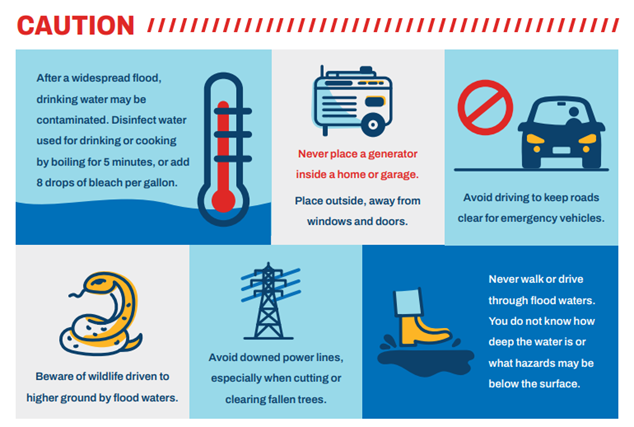
For more information about what to do after a hurricane passes, visit: https://www.weather.gov/safety/hurricane-after
IMPORTANT WEATHER LINKS:

When is Florida’s hurricane season?
Florida’s hurricane season runs from June 1 through November 30 each year. Early forecasts for 2025 predict an above-average season, with at least 19 named storms and 9 hurricanes expected.
How do I prepare for a hurricane in Florida?
Start preparing before hurricane season:
- Know your evacuation zone and flood risk
- Create a family and pet evacuation plan
- Build an emergency supply kit with 3-5 days of food, water, and medicine
- Review your insurance policy and document your home and valuables
- Secure your property by trimming trees, boarding windows, and clearing gutters
What should I include in my hurricane supply kit?
Your kit should include:
- 3-5 days of non-perishable food and water (1 gallon per person per day)
- Prescription medications and first-aid supplies
- Flashlights, batteries, and phone chargers
- Personal hygiene products and sanitation supplies
- Important documents like IDs and insurance policies
- Cash (ATMs may not work after the storm)
What should I do if I’m ordered to evacuate?
- Leave immediately and follow official evacuation routes
- Bring your supply kit, medications, and important documents
- Secure your home before you leave
- Inform family and friends of your evacuation plan
- Don’t wait until it’s too late—roads may become impassable
What if my hurricane insurance claim is denied or underpaid?
If your insurance company denies or underpays your hurricane damage claim, call Yon Law at (888) 937-8968. We help Florida homeowners fight for the compensation they deserve—no fees unless we recover for you.
How can I find my evacuation zone in Florida?
You can search for your evacuation zone by address on the Florida Division of Emergency Management website:
Is flood damage covered by homeowners insurance in Florida?
No. Standard homeowners insurance does not cover flood damage. You must purchase a separate flood insurance policy through the National Flood Insurance Program (NFIP) or a private insurer. Don’t wait—flood policies often have a 30-day waiting period.
This Hurricane Preparation Guide is for general informational purposes only and does not constitute legal advice., It may not cover all relevant issues or apply to your specific situation. The author expressly disclaims any liability for any loss or damage resulting from reliance on the information contained in this guide. Use of this guide does not create an attorney-client relationship. For advice tailored to your circumstances, consult a licensed attorney.

